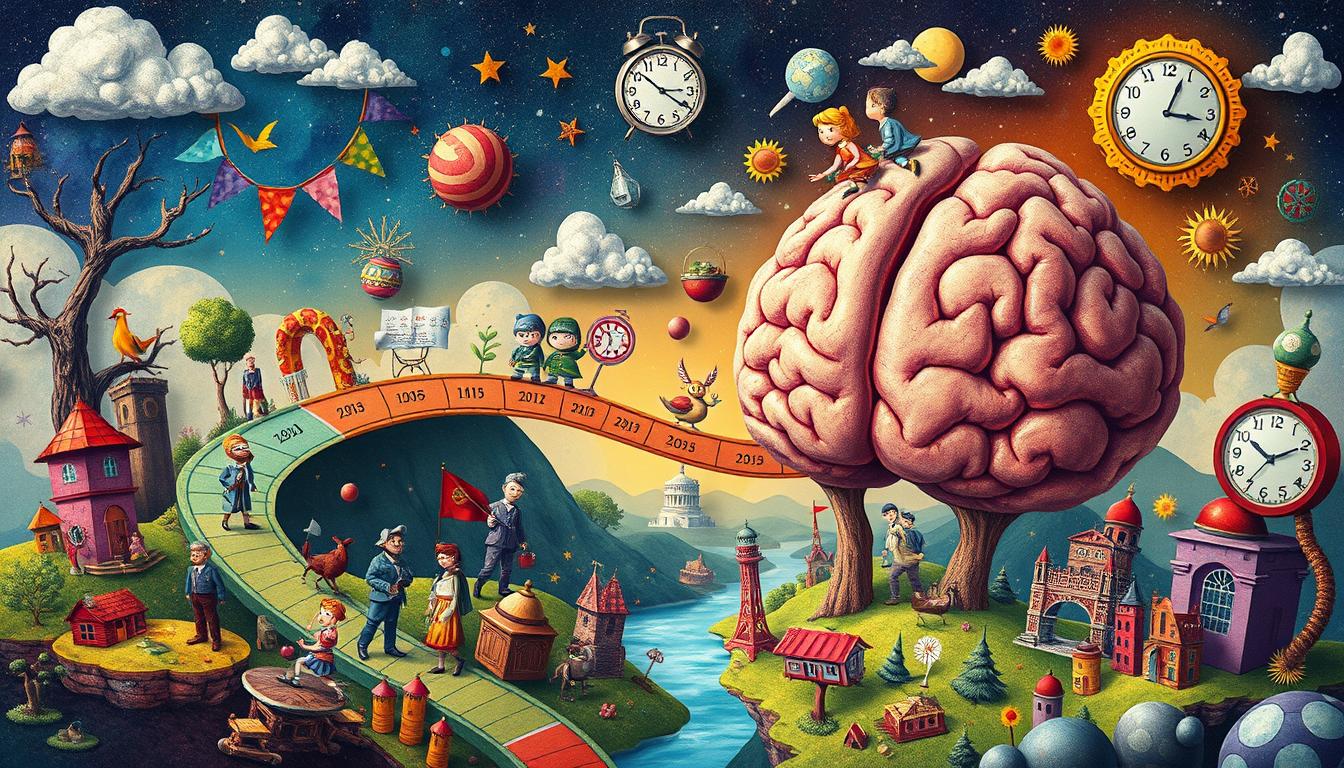In this guide, we’ll look at different mnemonic techniques to help you remember historical dates and events. You’ll learn from simple acronyms to the powerful method of loci. These strategies will improve your memory and help you understand the key moments in history.
Key Takeaways
- Learn mnemonic techniques to enhance your recall of historical dates and events
- Discover effective memory aids such as acronyms, acrostics, and the method of loci
- Explore strategies to create personal and cultural associations for better memorization
- Unlock the power of visualization and sequential memorization techniques
- Master the art of mnemonics and boost your academic and professional performance
Unleashing the Power of Mnemonics
Mnemonics are powerful tools for our brains. They help us remember historical dates and events better. By learning about these techniques, we can master even the toughest historical facts.
What are Mnemonics?
Mnemonics are systems that help our brains remember information better. They use our brain’s natural way of linking and organizing things. This makes complex data easy to remember.
The Importance of Remembering Historical Dates
Knowing historical dates and events is key to understanding the past. It helps us see how the past affects today. When we remember important moments, we get a clearer view of the world.
Using Mnemonic Techniques, Associative Learning, and other Memory Aids boosts our ability to remember history. This makes us appreciate the world’s history more.
“The study of history is the best way to understand the present.” – Carl Becker
In the next parts, we’ll explore different Mnemonic Techniques. These will help you become great at remembering historical dates and events. You’ll become a true history lover.
Mnemonic Techniques for Remembering Historical Dates and Events
Remembering historical dates and events can be tough. But, with the right mnemonic techniques, we can improve our memory. This lets us better understand the past. We’ll look at various methods to help us remember important dates and events.
Using acronyms and acrostics is a great way to remember things. We can turn a list of dates or events into a catchy phrase or word. For example, “HOMES” helps us remember the Great Lakes: Huron, Ontario, Michigan, Erie, and Superior.
- Acronyms: Transforming dates or events into a memorable phrase or word
- Acrostics: Using the first letters of a series of items to create a memorable word or phrase
The method of loci, or “memory palace” technique, is also powerful. We imagine a place we know well, like our home or office. Then, we link historical events to spots in that place. This makes remembering information easier.
“The mind is like a garden; if you don’t plant the seeds of knowledge, it will be overrun with the weeds of forgetfulness.” – Anonymous
Associative learning is another good strategy. We connect new historical info to something we already know. This makes remembering dates and events easier.
In the next parts, we’ll explore more mnemonic techniques. We’ll give you a full set of tools to remember historical dates and events easily.
Acronyms and Acrostics: Making Letters Work for You
Remembering historical dates and events can be tough. But, we have a secret tool. Acronyms and acrostics make hard-to-remember info easy to recall. Let’s see how these clever tricks can boost our historical knowledge.
Acronyms turn dates and events into short, memorable words. For instance, “1776” becomes “In 1776, our nation’s birth.” This way, we can easily remember important historical facts.
Acrostics go further by using the first letters of a phrase to spell out a word or date. Think of trying to recall the Gettysburg Address. An acrostic like “FOUR score and seven years ago” can help you remember it quickly.
- Acronyms: Transforming dates and events into easy-to-remember phrases
- Acrostics: Using the first letters of a phrase to spell out a historical fact
- Combining these techniques can create powerful mnemonic tools for Acronyms for Dates and Historical Mnemonics
These methods are simple and flexible. They help students and history buffs alike. Acronyms and acrostics are your best friends for learning history.
When faced with many historical dates and events, don’t worry. Use Acronyms for Dates and Historical Mnemonics to make them easy to remember. Your brain will appreciate it, and your history knowledge will grow.
The Method of Loci: Visualizing Your Way to Success
Discover the “memory palace” technique, a strong mnemonic strategy used for centuries. It helps remember complex information by linking historical dates and events to places you know well. This way, recalling these details becomes easy.
Creating a Memory Palace
To start with the method of loci, build your own “memory palace.” It could be a familiar building or your childhood home. Make sure you know it well. Picture each part of it in detail, creating a mental map for storing and recalling information.
Placing Historical Events in Your Mind Palace
After setting up your memory palace, fill it with historical dates and events. Picture each item in a specific spot in your mind, using visualization techniques to make it vivid. Engaging more senses like sight, sound, smell, and touch will strengthen the memory.
By using the Memory Palace Method and visualization techniques, you’ll have a powerful tool for remembering historical facts. Start building your memory palace today!

Rhymes and Songs: Turning Dates into Melodies
Mnemonics aren’t just about acronyms and pictures – they can also be rhymes and songs. Making historical dates and events into catchy tunes helps us remember them better. Let’s see how to make these musical historical mnemonics more engaging and easy to recall.
Rhymes and songs are great for remembering things because our brains love music. By turning history into songs, we tap into our musical memories. This makes remembering easier.
Creating your own rhymes and songs is fun and creative. First, pick the dates or events you want to remember. Then, try out different songs and melodies until you find the perfect one. Remember, the sillier and more fun your mnemonic is, the better it will stick in your mind.
After making your rhyme or song, practice it often. The more you use it, the stronger it will stay in your memory. You can even share it with others, making learning a fun group activity.
So, let’s get creative and make those historical facts into rhymes and songs! With a bit of imagination and music, we can make history into a song that will last a lifetime.
Associative Learning: Linking the Unfamiliar to the Familiar
Learning historical dates and events can seem hard. But, Associative Learning makes it easier. It connects new info to what we already know. This way, we can remember and keep important details in mind.
Personal Associations
Creating personal connections is a great way to use Associative Learning. Think of how you can link historical events to your life. This could be through your interests, jokes, or experiences. For example, you might remember the Normandy Landings by associating it with your grandmother’s birthday.
Cultural and Historical Associations
We can also link events to cultural or historical contexts. This makes them easier to remember. For instance, the invention of the telephone can be linked to the industrial revolution or technological progress.
By using Associative Learning and Memory Aids, remembering history becomes fun. Let your creativity make connections that help you learn from the past.
The Peg System: A Handy Tool for Sequential Memorization
The Peg System is a great tool for learning historical dates and events. It’s a clever way to organize information so it’s easy to remember. This method is especially useful for remembering complex timelines.
This system uses “peg” or visual cues to link information. These pegs are often numbers or objects we know well. They help us remember historical facts and their order easily.
- First, learn a set of “peg words” like “one is a bun, two is a shoe, three is a tree.” Or use objects like a balloon, a chair, or a sun.
- Then, connect each historical event or date to its peg word. Imagine the event happening with the peg object. Make the image as vivid as you can.
- When you need to recall the information, just go through your peg words in order. The historical facts will come back to you.
The Peg System is very flexible. It works for learning about kings and queens or the battles of a war. It turns hard timelines into easy-to-remember mental pictures.
“The Peg System is a game-changer for anyone who struggles to remember historical dates and events. It’s a simple yet incredibly effective way to turn dry information into a captivating mental journey.”
Try the Peg System and see how it works for you. With a bit of practice, you’ll become a pro at remembering history. You’ll impress your friends and do well in school.
Visualization Techniques: Bringing Dates to Life
Visualization is a strong way to remember historical dates and events. It lets us create clear mental images. We’ll look at how to make these images and use visual tools to keep information in mind.
Creating Mental Images
One great way to remember dates is to link them to personal images. By turning abstract info into real pictures, we use our brain’s visual skills. Start by imagining the event, focusing on its details, colors, and feelings.
The more vivid and unique the image, the better you’ll remember it.
Using Visual Aids
We can also use outside visual tools to help remember dates. Timelines, infographics, and more can organize and make info easier to recall. Try different visuals to see what works best for you.
| Visualization Technique | Benefits | Examples |
|---|---|---|
| Mental Imagery | Taps into the brain’s natural visual processing abilities, creating memorable associations | Picturing a historical event unfolding in your mind’s eye, complete with sensory details |
| Visual Aids | Organizes information, provides context, and reinforces learning | Timelines, infographics, and other visual representations of historical events |
By using Visualization Techniques and Memory Aids, we can change how we learn and remember history. With creativity and practice, you’ll get better at remembering historical dates and events.

Mastering the Art of Mnemonics
Mnemonic Techniques, Memory Aids, and Memorization Strategies are great for remembering historical dates and events. Now, let’s dive deeper into mastering mnemonics and using these techniques every day.
Success comes from trying different mnemonic methods and finding what works for you. What works for one person might not work for another. So, it’s key to be open and try new things.
Start by creating a memory palace – a mental space where you link historical info to places you know. This method, the Method of Loci, is great for remembering things in order.
Another good strategy is associative learning. This means linking new info to things you already know. You can make personal connections or link to cultural and historical references.
- Try out different Mnemonic Techniques to see what fits you best.
- Make it a habit to use Mnemonic Techniques in your studies.
- Use a mix of Memory Aids for a more complete approach to Memorization Strategies.
Mastering mnemonics is a journey, not a finish line. With regular practice and patience, remembering historical dates and events will become easy. Use Mnemonic Techniques to become a better history enthusiast!
“The true art of memory is the art of attention.” – Samuel Johnson
| Mnemonic Technique | Description | Example |
|---|---|---|
| Acronyms | Creating a word from the first letters of a list of items | HOMES to remember the Great Lakes: Huron, Ontario, Michigan, Erie, Superior |
| Acrostics | Forming a phrase or sentence from the first letters of a list of items | “King Phillip Came Over For Good Soup” to remember the taxonomy classification: Kingdom, Phylum, Class, Order, Family, Genus, Species |
| Method of Loci | Associating information with familiar locations in your mind | Placing the signing of the Declaration of Independence in your kitchen, the Battle of Gettysburg in your living room, and the moon landing in your bedroom |
Conclusion
In this guide, we’ve looked at many ways to remember historical dates and events. These strategies can make learning fun and help you remember important moments. You’ll impress others with your knowledge of history.
We’ve shown you how to use acronyms, acrostics, and the Method of Loci. These Mnemonic Techniques for Remembering Historical Dates and Events help your brain remember better. You can turn dates into rhymes or make personal connections.
Keep using these Memory Aids as you learn more about history. Try different Memorization Strategies to find what works best for you. Your knowledge will grow every day. The memories you make now will last forever.




